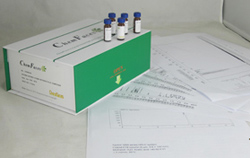Hot Products



| Catalog No. | Information |
| CFN98344 | Reynosin Reynosin has hepatoprotective, and anti-inflammatory effects, it has protective effect against dopamine-induced neuronal cell death, which may be due to the reciprocal up-regulation of E6-associated protein and down-regulation of α-synuclein protein expression. Reynosin exhibits a dose-dependent inhibition on CINC-1 induction in LPS-stimulated NRK-52E cells, where 50% of inhibitory effect was shown at the concentration of about 1 microM. Reynosin also has strong anti-mycobactericidal activity, with a minimal bactericidal concentration (MBC) of 128ug/mL against the H37Rv, 366-2009 and 104-2010 Mtb strains and a minimal inhibitory concentration (MIC) of 64, 64, 128, 128 and 128ug/mL against the H37Rv, 104-2010, 63-2009, 366-2009 and 430-2010 Mtb strains, respectively. |
| CFN96236 | Reynoutrin Reynoutrin has antioxidant activity. |
| CFN70409 | Rhamnazin Rhamnazin, a novel inhibitor of VEGFR2 signaling with potent antiangiogenic activity and antitumor efficacy, it attenuates inflammation and inhibits alkali burn-induced corneal neovascularization in rats. Rhamnazin has anti-oxidative, and anti-inflammatry activities, it also shows apoptogenic activity via mitochondrial pathway and associated with activation of caspase-9 and -3. |
| CFN95116 | Rhamnetin 3-galactoside Reference standards. |
| CFN97724 | Rhamnocitrin Rhamnocitrin can enhance the immune function, improve the formation of spleen cells of mice serum hemolysin of chicken red blood cell immune. Rhamnocitrin possesses significant anticataract activity and acts most likely due to its antioxidant property, it shows a significant protection against cloudiness in lenses induced by hydrogen peroxide and hydrocortisone in a dose dependent manner.Rhamnocitrin and kaempferol can augment cellular antioxidant defense capacity, at least in part, through regulation of HO-1 expression and MAPK signal transduction; they not only protect low-density lipoprotein from oxidation but also prevent atherogenesis through suppressing macrophage uptake of oxidized low-density lipoprotein. |
| CFN95145 | Rhamnocitrin 3-apiosyl-(1->2)-glucoside Reference standards. |
| CFN95134 | Rhamnocitrin 3-glucoside Reference standards. |
| CFN98569 | Rhaponiticin Rhaponticin(Rhaponiticin) has a noticeable antidiabetic effect and could be potentially used as a new agent to treat type 2 diabetes mellitus and its complications, it can alleviate liver steatosis and improve blood glucose and lipid profiles in KK/Ay diabetic mice. |
| CFN91100 | Rhaponticin 2''-O-gallate Rhaponticin 2''-O-gallate showed inhibitory activity of NO production in lipopolysaccharide-activated macrophages, (IC50 = 11-69 microM). |
| CFN92607 | Rhapontigenin Rhapontigenin has antioxidative, antihyperlipidemic, antifungal and anticancer activities. Rhapontigenin inhibits HIF-1α accumulation and angiogenesis in PC-3 prostate cancer cells, suppresses breast cancer cell migration and invasion, which is involved in inhibiting the PI3K-dependent Rac1 signaling pathway. Rhapontigenin exhibits dose-dependent inhibition of tyrosinase activity and melanin synthesis in B16F10 melanoma cells. |